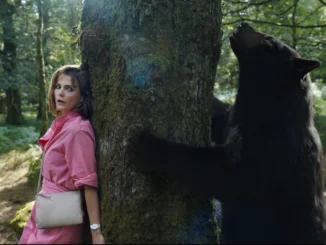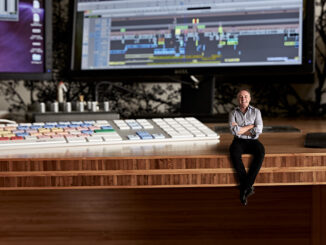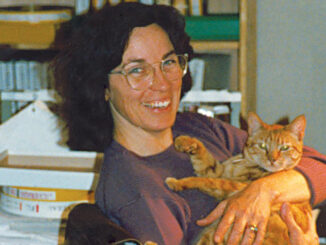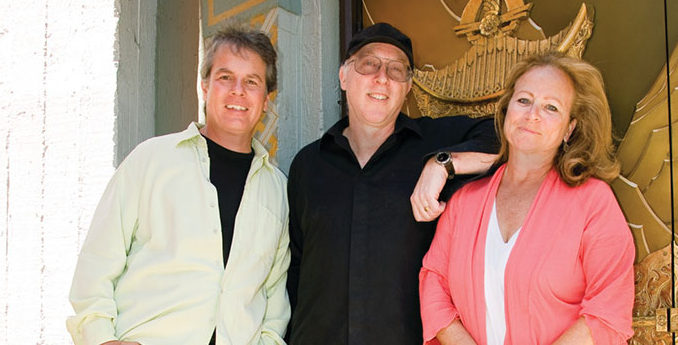
by Debra Kaufman
From hyper-real audio effects to vintage-sounding equipment, the sound in a Quentin Tarantino film is always distinctive. And from his Kill Bill: Vol. 1 in 2003 up to the current Inglourious Basterds, it has been the handiwork of supervising sound editor Wylie Stateman and sound designer Harry Cohen, MPSE, both of whom relish the experience of working with the director.
“Quentin is one of the most stylistically unique filmmakers of our generation,” says Stateman. “He is an auteur-type filmmaker––meaning he’s a writer, director, producer and truly a visionary type.” Part of Tarantino’s distinct style, says Stateman, is his relationship with his long-time editor, Sally Menke, A.C.E. “Sally has been a consistent part of Quentin’s method over the years, helping to explore his intentions as a storyteller,” he says. Cohen agrees, observing that he and Stateman are part of that process. “We figure out what works for Quentin and Sally and their process,” he adds.
That process is just a little bit different from the way many other films are done, according to Cohen. “We do as much of the work as we can upfront and try to get it to them so they can put it in the Avid and get comfortable with specific creative ideas,” he says. “This is an ideal way to start the dialogue between the filmmakers and sound.” As in any relationship with a director, it’s also about learning his or her personal preferences. Over the years, Stateman and Cohen certainly have learned Tarantino’s. “For instance, when Quentin wants something big, he isn’t necessarily talking about low end,” says Cohen. “He likes a wide dynamic range.”
From the first film they worked on with Tarantino, the process has been about discovery. “Quentin is essentially a member of the audience; he’s able to see things fresh,” says Stateman. “That’s a very unique quality for someone who brings to the table as many departments as he commands. But he’s a genuine audience member and has a great ability to see things as if for the first time. He can sense the way his audience would appreciate seeing things.”
“In discussing early on how Sally and Quentin wanted to represent the 1940s style, we offered a two-version approach… One way was to mechanically enhance the sounds to make it sound vintage. The second approach was a digital version using ProTools and plug-ins… The digital version won, but only after we explored the mechanical option.” – Wylie Stateman
When questioned how they would describe Tarantino’s style, Stateman and Cohen defer to Menke’s recent characterization. “Sally remarked a couple of months ago that his movies often live in the strange place where violence and humor intersect,” offers Cohen. Wylie agrees absolutely, adding “Quentin blends familiar themes with the avant garde and he insists on contrasting violence and humor—or making something so violent that it crosses the boundary of violence and becomes funny…if you get the joke. If you get it, you become one of his audience.”
Despite Tarantino’s very distinctive style, Stateman said there was no adjustment period at all when they first began working together in 2003. “Harry and I are very much in the mindset of adjusting to the filmmakers we work with,” he says. “That’s a big part of what Harry and I—and what Soundelux––bring to the table. We work for the filmmakers; we help them explore their goals and intentions. A big part of our job is to be as accessible and as easy to work with as possible.”
It would be easy to imagine Tarantino making demands in the audio suite. But Stateman shrugs it off. “Directors are demanding, especially ones that are complete filmmakers,” he says. “Great directors demand your absolute best. They demand deep thinking and high-quality execution. They demand that you listen to them and pay attention to the way they want to tell stories.”
Tarantino is a “wonderfully identifiable stylist” and, as such, “demands that we deliver within his style of really high-quality, highly intellectualized and well-crafted work,” according to Cohen, who explains that working with Tarantino also requires a deep knowledge of the history of filmmaking. “He’s a huge and very knowledgeable fan of films throughout the ages,” he adds. “A lot of times, his work contains purposeful references to other movies. He likes it when we’re aware of that.”
Just as Tarantino and Menke have worked together for years, so Stateman and Cohen have a 20-year history of collaborating, starting with Oliver Stone’s Talk Radio in 1988. “We’ve never regretted a moment of our collaboration,” Stateman says, noting that the two have “enjoyed working on a wide variety of filmmaking genres, including several with auteur, final cut directors,” such as Stone and Tarantino.
Cohen explains that the duo has “experimented with the shape of the process we do, and changed it to fit the style of different directors and their cutting rooms.” “It’s not just the director’s style but the collaboration between director, editor, production and post-production sound departments, taking the creative process from script to mix,” adds Stateman.

Likewise, Stateman and Cohen have a nearly 20-year relationship working with editor Menke. “She is a very good communicator, and is very generous in terms of talking about her needs and Quentin’s intention; she’s really an ideal partner for us,” says Stateman. “The time that Harry and I have spent together has made us comfortable and familiar, and Sally is very much a part of a comfortable, very close-knit working environment.”
The familiarity that the three share enables them to use a kind of shorthand to communicate. “That familiarity defines the workload and focuses the effort on developing things that will be important to what’s on screen and in the final mix,” offers Stateman. “There’s not a lot of waste. And that’s what’s so wonderful about a small, close crew. We produce material quickly that goes into the track easily and effectively. It’s a very efficient working strategy.”
Cohen notes that this way of working means that they try “to bring what is essential and relevant to the mix. We try to pre-refine the material so that when we bring it in, what we’re presenting is the stuff that will help in play,” he adds. “If we’re missing something, it’s easier to add it on the mix stage––with all the sound elements present and the principals in the room––than it is to try to figure out which track, out of the many we’ve brought, needs to be turned off, to achieve clarity.”
One interesting part of the collaboration for Inglourious Basterds involved Nation’s Pride, a Nazi propaganda film within the movie. Stateman and Cohen went to Berlin to create the mix for it. “The movie-within-a-movie is in the 1940s style of Goebbels and Riefenstahl, and is the cornerstone of the third act,” explains Stateman, who reports that their first assistant, Brandon Spencer, and re-recording engineer, Michael Keller, CAS, accompanied them to Berlin, where they prepared the tracks and mixed for close to a month.
The challenge here was to make the movie appear as if it were mixed in the late 1930s or early 1940s. “In discussing early on how Sally and Quentin wanted to represent the 1940s style, we offered a two-version approach,” reveals Stateman. “One way was to mechanically enhance the sounds to make it sound vintage. The second approach was a digital version using ProTools and plug-ins.”
The mechanical version played back the mix on a 1930s Magnavox speaker with a metal horn. “It sounded interesting but more like an early 1930s sound than one from the early 1940s,” says Stateman. “The digital version won, but only after we explored the mechanical option.”
The digital version relied on a step-by-step chain to re-create the key aspects of the sound in that era. First the sound went into the Renaissance compressor to even out the dynamic range, and then the Reaktor tube emulator, which provided analogue-sounding saturation. The next step in the chain was into another Reaktor plug-in that was used to add wow, flutter and optical pops. Next, it went into the Meequalizer, which is modeled on an old equalizer and used to impart a vintage sound to the mid-range. From there, it went into Analog Channel, which simulates tape saturation; and lastly, into the Grm EQ, which was used to shape the overall sound, and roll off some low and high end. “Reaktor is a ‘framework’ plug-in that does many different things, depending on which ‘ensemble’ you open,” explains Cohen, who says there are well over 1,000 “ensembles” for Reaktor.
Stylistically, Inglourious Basterds’ sound may be a little sparser than Tarantino’s other films, says Cohen, but that’s in keeping with the movie’s period. “In these older movies, they didn’t cover every actor’s little move in Foley or layered sound effects,” he points out. “Back in those days, they might have had three or four channels––unlike today, where it’s limitless.”
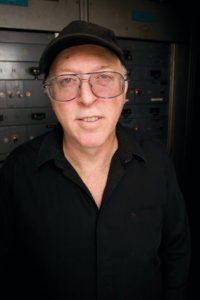
Yet there are moments when the sound track goes into incredible detail. “Sometimes in Tarantino’s films, you will hear things you wouldn’t ordinarily hear, in a kind of audio hyper-realism––such as the sound of the sugar when it pours off the spoon into a cup of coffee,” says Cohen. “There’s a scene in a restaurant and as the dialogue between two characters gets more intense, the sounds of the restaurant fade way, in an almost unnoticeable way and the sounds they make get more intense and detailed.”
There’s a reason behind those choices. “Quentin likes to narrow the focus of the sound track, often to enhance the intensity,” says Stateman. “In the end, audio is there to help support the telling of the story. It’s the invisible dimension.”
With regard to music, Tarantino’s long-time collaborator Mary Ramos was music supervisor on Inglourious Basterds. The director has a huge archive of vinyl records, says Cohen, and most of the music choices came from his collection. That’s all part of the process of working with the auteur director, who has a vision for every facet of the movie, not the least of which is the soundtrack.
“Working with a filmmaker like Quentin Tarantino is really about working with someone who knows exactly what he wants to accomplish and has the desire to involve himself in all aspects of the filmmaking process,” summarizes Stateman, who notes that Michael Minkler and Tony Lamberti were the new film’s re-recording engineers. “He understands, in detail, the story as a writer would. He understands, in detail, the goal and the intention of the film, as a producer would. And he is every bit the visionary director that people have come to know him as.”



